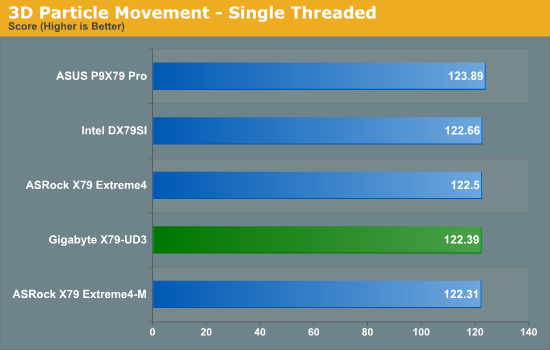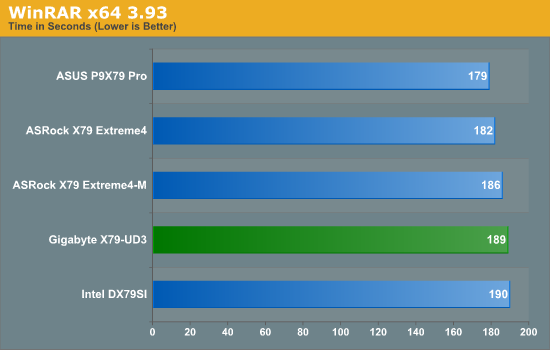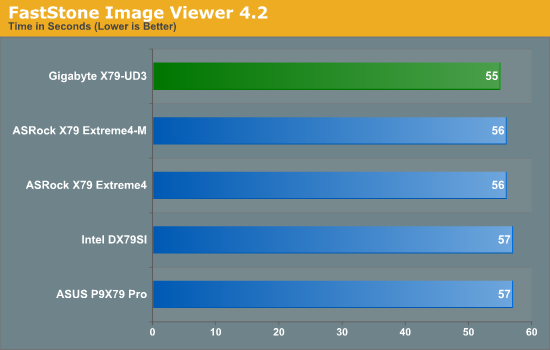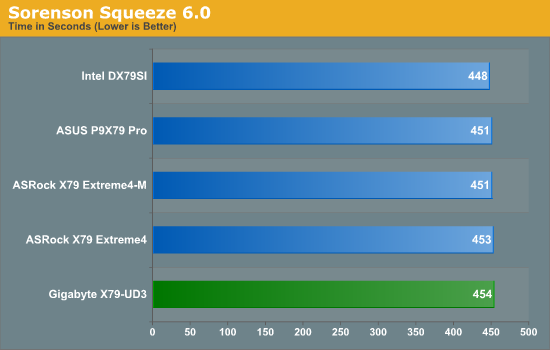Gigabyte GA-X79-UD3 Review
by Ian Cutress on December 26, 2011 4:37 PM EST- Posted in
- Motherboards
- Gigabyte
- X79
- Sandy Bridge E
3D Movement Algorithm Test
The algorithms in 3DPM employ both uniform random number generation or normal distribution random number generation, and vary in various amounts of trigonometric operations, conditional statements, generation and rejection, fused operations, etc. The benchmark runs through six algorithms for a specified number of particles and steps, and calculates the speed of each algorithm, then sums them all for a final score. This is an example of a real world situation that a computational scientist may find themselves in, rather than a pure synthetic benchmark. The benchmark is also parallel between particles simulated, and we test the single thread performance as well as the multi-threaded performance.


One of the more disappointing results by the Gigabyte board was in the 3D Particle Movement MultiThreaded result. It is comprehensively lower in this test, despite it being a wholly CPU bound benchmark. This is somewhat seen in the other multi-threaded benchmarks as well.
WinRAR x64 3.93 - link
With 64-bit WinRAR, we compress the set of files used in the USB speed tests. WinRAR x64 3.93 attempts to use multithreading when possible.

Again with this test, the Gigabyte is still behind its main competitors.
FastStone Image Viewer 4.2 - link
FastStone Image Viewer is a free piece of software I have been using for quite a few years now. It allows quick viewing of flat images, as well as resizing, changing color depth, adding simple text or simple filters. It also has a bulk image conversion tool, which we use here. The software currently operates only in single-thread mode, which should change in later versions of the software. For this test, we convert a series of 170 files, of various resolutions, dimensions and types (of a total size of 163MB), all to the .gif format of 640x480 dimensions.

Real-world single thread performance seems fine on the board though, with the Gigabyte achieving the best time we've ever seen for our FastStone benchmark.
Sorenson Squeeze 6.0 - link
Sorenson Squeeze is a professional video encoder, complete with a vast array of options. For this test, we convert 32 HD videos, each a minute long and approximately 42 MB in size, to WMV 512KBps format. Squeeze can encode multiple videos at once, one for each thread.

While for the Squeeze benchmark we have the lowest X79 result again for the Gigabyte board, this time the differences are not so large between the other boards.










39 Comments
View All Comments
MadMan007 - Monday, December 26, 2011 - link
There are other ways to implement fan control than PWM though, namely voltage control which works with any fan even 2-pin ones with no RPM sensor plus all the 3-pin aftermarket fans. Even if all it did was allow for altrered voltage, or simple software with manual profiles (ie: 'quiet' at a certain voltage' and 'high performance' at another voltage) it would be a big step up from no fan control. Of course that probably costs about $1 in additional parts so god forbid many motherboards have that.In the end it just means having to stick with a real manual fan control but it would be nice to see on motherboards.
gevorg - Wednesday, December 28, 2011 - link
True but not all mobo manufacturers are as cheap as Gigabyte in this regard. Basic P67/Z68 mobos from Intel and Asus/ASRock have case fan controls and some even by PWM.Andrea deluxe - Tuesday, December 27, 2011 - link
http://www.techpowerup.com/157543/Gigabyte-Recalli...Andrea deluxe - Tuesday, December 27, 2011 - link
http://www.youtube.com/watch?v=J_Wk4QWHjpcBrandenburgh Man - Tuesday, December 27, 2011 - link
It's silly to criticize Gigabyte's Multi-Threaded 3D Particle Movement score when the difference between Gigabyte's score of 898.96 and the highest score of 914.36 is less than 2 percent. In the real world, anything less than a 10 percent performance difference is unnoticeable by the user. Typically you have to get 20 to 25 percent better performance before it becomes meaningful to you, and 33 percent or better before you start getting excited about it.wifiwolf - Tuesday, December 27, 2011 - link
If you mean motherboard performance benchmarks are by far less meaningful i agree.That's because this is the less significant part in your system performance-wise, which means 2% difference overall is enough to say it's too much for an high-end.
cactusdog - Tuesday, December 27, 2011 - link
Gigabyte has recalled this board because of a too weak VRM that alows mosfets to explode when overclocking,UD3/ UD5, A1 Assassin all RECALLED by Gigabyte
rumblpak - Tuesday, December 27, 2011 - link
Shouldn't you note that they've all been recalled? Gigabyte announced a worldwide recall of all of their X79 boards.surt - Tuesday, December 27, 2011 - link
Who is buying an x79 and only getting 4 memory slots anyway? That's just crazy. If you want this platform at all, you surely want the large amount of memory it can support. If for nothing else, you can run a nice ramdisk and get things running 10x faster than the best SSD you can buy.Brandenburgh Man - Tuesday, December 27, 2011 - link
I thoroughly agree. SSDs are great for fast boot times and fast program loads, but when you really need *superfast* access to data, nothing beats a RAM drive.Although 4GB DDR3 sticks are dirt cheap right now, four memory slots only comes to 16GB. A six-core hyper-threaded Sandy Bridge E chip would quickly exhaust that if you're a power user who does a lot of video editing or transcoding while simultaneously running other programs. Even if you can afford the currently very expensive 8GB DDR3 sticks, 32GB isn't anything to brag about for a workstation class computer. Better to get a mobo with 8 slots and populate it with 32GB now, then upgrade to 64GB a year or so later when 8GB sticks becine more affordable. Then you'd have the best of both worlds, a huge RAM-disk for incredibly fast I/O, with enough system RAM left over to keep the CPU from being starved.
A few years ago Jerry Pournelle said we were entering the age of computational plenty. I like to say we're entering the age of desktop supercomputing. The future looks very bright indeed.